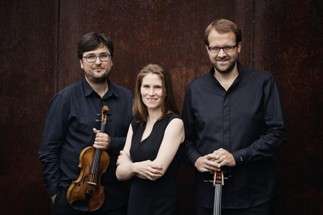|
Back
Old Favorites Overshadowed by Rare Bookends Washington
The Kennedy Center
03/26/2019 -
Frank Martin: Trio on Irish Folk Tunes
Felix Mendelssohn: Trio No. 1 in D minor, Op. 49
Franz Schubert: Trio No. 2 in E-flat major, D. 929, Op. 100
The Morgenstern Trio: Catherine Klipfel (Piano), Stefan Hempel (Violin), Emanuel Wehse (Cello)

S. Hempel, C. Klipfel, E. Wehse
In some respects, the most intriguing and memorable part of Tuesday’s Fortas Chamber Music program, featuring Germany’s impressive Morgenstern Trio, was the first piece, the unusual (in more senses than one) Trio on Irish Folk Tunes by the 20th-century Swiss composer Frank Martin. Martin penned this work in the 1920’s, relatively early in his career, when his style lay somewhere between full-blooded late Romanticism and the more angular and austere Modernism he would later settle into, if not quite as abrasively as some of his better-known peers. Yet this is less conventionally Romantic a work than the roughly contemporaneous Piano Quintet. Martin had been commissioned by an American patron to produce a piano trio built upon traditional Irish melodies, of his own choice, and he accordingly spent some time familiarizing himself with that repertoire.
Presumably the patron—who, the program notes inform us, was unsatisfied with the final product—expected a sort of Irish Dvorák, with the whole work capturing the local color of the folk idiom, only presented in classical form. Yet Martin produced something more surprising; here he preserves the character of his Irish melodies—and he manages to squeeze a good number of these into the three-movement work—but treats them in unexpected and often jarring ways: overlapping with one another so as to create a touch of dissonance, for instance, or simply with edgy or dark harmonic coloring. As one who has a deep fondness for Irish folk music, I found the piece at its best—namely, I think, the whole third movement—to combine the familiar and the unsettling in a highly effective way. As for the performance, it seemed more stylistically tentative at times than it might have, but for the string players at least it must be somewhat unclear what to do here, where one must bring out the counterpoint and cannot simply resort to a loose Irish fiddle style complete with drones and sliding.
As enjoyable as this was, the Morgenstern Trio found itself on presumably surer ground in the following Mendelssohn D minor Trio. Mendelssohn was of course a complete master of instrumental color, and the first thing to note about this work, the more popular of his two essays in the genre, is how weighty a sound the composer is able to extract from his small ensemble. This is reflected to great effect in the first movement’s stormy minor-key opening, which at first leads one to expect a work of brooding, almost Beethovenian drama. Yet the second subject soon brings us one of Mendelssohn’s characteristic disarmingly ingratiating melodies, and tellingly it is this material that dominates the development. Haydn had done something similar in his Symphony No. 95, which—alone among his late symphonies—begins in a minor key, and ominously at that, yet soon moves into major keys, where nearly the whole rest of the piece stays, the “Scherzo” excepted. Yet with Mendelssohn here the contrast is more stark, perhaps too stark; and in spite of the palpable nervous energy of the finale, the work on the whole does not achieve as much dramatic unity as it might. Mendelssohn’s writing here is so consistently enchanting, however, that I should not press the point too hard. And certainly the Morgenstern players generally threw themselves into the music with style and vigor. I was initially disconcerted by cellist Emanuel Wehse’s very legato statement of the opening theme, but what followed was by no means an overly suave performance, rather one with a healthy dose of expressive variety joined to lovely tone from all involved.
I have long found been ambivalent in my reaction to Schubert’s large-scale works—even the celebrated C major String Quintet has seldom moved me—and so true Schubertians may wish to stop reading here. Even though Schubert’s generally variable skill at transitions is basically at its peak in the Second Piano Trio, the longer of his two piano trios, for all its charms this work reminds me why I do not always warm to the composer. Schubert’s melodic invention here is both inspired and seemingly endless, it is true. Yet there is so little sense of dramatic structure—of really robust contrast among themes and among movements, of long-term direction—that one simply has to give oneself over to Schubert’s admittedly very eloquent stream of consciousness. For my part, I struggle to do so for the duration of the piece, which can take over 40 minutes in performance (although I did not time yesterday’s). In playing such a rhapsodic work, it is essential to bring an expressive conviction and feel for ebb and flow, and the Morgenstern left nothing to be desired here. The players bring out the flow and shape of the music yet are not afraid to dig in with conviction either. Their inspired choice of an encore, the second of Ernest Bloch’s Nocturnes for Piano Trio, brought a comparably exquisite performance. For me, this and the Martin were the highlights of the evening, as much as I love Mendelssohn.
Samuel Wigutow
|